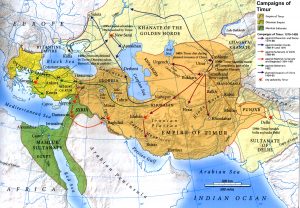by Mustafa Banister

“Then, leaving Samarqand, Tamerlane hastened to Syria, taking with him the leaders of his army, and taking delight with that great company, journeyed in the beginning of the year 802/1399, and poured with that deluge from the Oxus into Khurasan; and the reason for his expedition into Syria was the crime of Qadi Burhaneddin, lord of Siwas, against his barbarian envoys; nevertheless he wished that his aim should be doubtful and to conceal from men his departure and position. I have improvised these verses :
How can the splendor of the sun be withdrawn from the eyes, when the day is already bright?
And how shall be hidden the fragrance of musk, which fills the nostrils of men on a warm day?
And how shall the sound of a drum at the time of flight be concealed from the ear?”
(from Ibn ʿArabshāh’s Wonders of Destiny)
Not long after the Syrian civil war began in earnest in 2011, some modern commentators observed that the cities of Syria had not seen the same level of ruin and devastation since the invading armies of Tamerlane laid waste to Damascus and Aleppo at the turn of the fifteenth century. The memory of Tamerlane’s destruction of the Syrian cities would live long into the imaginations of contemporaries and those survived it. Nevertheless, cultural memories of Tamerlane would develop very differently inside and outside the late medieval sultanate of Cairo.
Only a boy of about eleven at the time, the future litterateur, religious scholar, and historian, Aḥmad ibn ʿArabshāh(d. 854/1450) would never be the same again after Damascus, his hometown, was sacked and he was taken prisoner by Tamerlane in 1400. While he spent his teen years in Samarqand (Tamerlane’s capital) learning Islamic sciences from other captive scholars, he dreamed of building the personal and professional connections that would allow him to support his family through a stable position as a teacher, scribe, or Ḥanafī qadi. He devoted the next twenty-two years of his life to learning Islamic sciences and seeking out masters in the courts and capitals of pre-modern Muslim West Asia: Khita, Khwarazm, Urganj, Astrakhan, Saray, Crimea, Bursa, and Edirne. In 1422, he returned to the Syrian lands of the sultanate of Cairo, ultimately settling in Damascus and trying to re-establish himself in existing social structures. He benefitted from a patronage relationship with the scholar ‘Alā’ al-Dīn al-Bukhārī who relocated to Damascus in 832/1429. After al-Bukhārī’s death in 841/1438, Ibn ‘Arabshāh focused on creating several works of adab and historiography that helped enhance his reputation. Frequent trips between Cairo and Damascus brought him into the orbit of other well-connected fifteenth century scholars among the civilian elite including Ibn Ḥajar, al-Maqrīzī, Ibn Taghrībirdī, and al-Sakhāwī. He spent much of the 1440s trying to instrumentalize his works of literature, particularly his scathing biography of Tamerlane (finished in 1437) and a panegyric for the new sultan al-Zahir Jaqmaq which he began and may have abandoned the next year.
You can find out more about the life and work of Ibn ʿArabshāh in the latest episode of our podcast, Dawla: New Histories of the Medieval Middle East!
https://soundcloud.com/dawla-new_histories/ibn-arabshah
